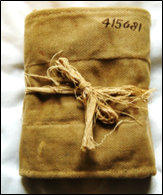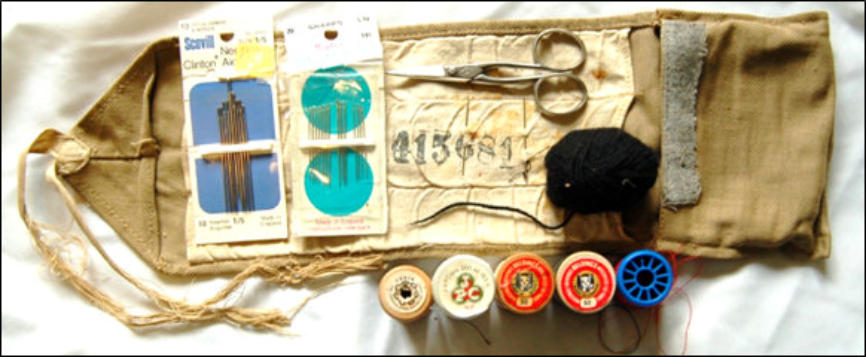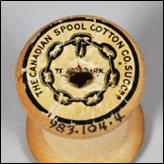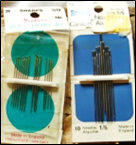
copyright © Wartime Heritage Association
Website hosting courtesy of Register.com - a web.com company
Wartime Heritage
ASSOCIATION
Herb Cunningham’s WWI Soldier’s Housewife
Herbert L Cunningham (1891-1982) will be long remembered for the 30 years he was
chief lightkeeper at Cape Forchu. Herb, his wife Grace and their six children spent 30
happy years living at the lighthouse and the account of their time at the Cape is
fascinating. However, before the Cape, Herb experienced his share of adventures
during WWI as a Canadian soldier in the trenches. Herb wrote many letters home
during WWI and luckily many of these letters have been preserved. Herb’s letters give
a great insight into his thoughts about surviving the war and a good picture of the
Canadian soldier’s life in WWI. The following is just a small sample of what these
letters have revealed.
In a letter Herb wrote to his mother 11 March 1916, he describes the contents of a
Canadian soldier’s “full kit”. Herb says the kit also includes “our housewife, which
consists of needle & thread, safety pins, buttons etc”. In March 2019 Herb
Cunningham’s “housewife”, the same one mentioned 103 years earlier, remarkably
made its way back to the Cunningham’s in Yarmouth. Its journey during those 103
years is totally unknown and it is amazing it made its way home. In early March 2019, Albert
Cunningham, Herb’s son, received a surprise call from a Mr. Campbell, a former Canadian army veteran
and resident of Winnipeg. Apparently, he and his wife had been looking through some old boxes of
sewing materials in their basement when Mr. Campbell, being a veteran himself, spied a soldier’s
“housewife”. Immediately he recognized that it had the WWI regimental serial #415681 and he went
online to check the Library & Archives Canada’s database to see whose number it was. He determined
Herb Cunningham from Yarmouth NS had been its owner. Mr. Campbell then tracked down a phone
number for Albert Cunningham in Yarmouth and called him.
Called a "housewife," the typical WWI sewing kit carried by Canadian soldiers included needles, thimble,
buttons, different thicknesses of thread, light wool for darning socks, gloves, and other woollen items, and beeswax for
waterproofing. The kit was made of khaki cloth with sewn in pockets and was closed by rolling it up and securing it with two cloth
ties. The history of the term “housewife,” used for a soldier’s sewing kit dates to 1749 in Britain. In those days military uniforms
were handmade and provided by each individual soldier. A sewing kit to maintain the uniform was a necessity. The sewing kits were
usually made by the man’s mother, wife, or other relative. They were often very personalized with elaborate embroidery, often the
man’s initials and it usually contained personal items. In the days before soldiers wore identity tags as they did in WWI the sewing
kit decorations and contents often helped the military identify a soldier lost in service that could not be identified any other way.
The picture above shows Herb’s “housewife” opened and displaying its contents as received in 2019. Not only was his serial number
written in ink on the outside of the kit, but the interior surface was also stamped with his number 415681 confirming its CEF army
roots. The kit contained 5 spools of thread, 2 packages of needles, a pair of scissors and a ball of black wool. In a letter that
accompanied the kit, Mr. Campbell mentions he had absolutely no idea how Herb’s “housewife” wound up in that sewing box or
even where the box had come from. He also said he could not say if any of the contents were original and at first glance one would
expect modern items had replaced the original contents. However, following some online research it appears some contents might
have been in the kit when it was issued to Herb.
Of the 5 spools of thread, one with a plastic core was obviously made after WWI. Two wooden spools of
thread have the label Belding Brothers & Co. Both use bilingual terms, and one is marked made in
Canada. Belding Brothers & Co, founded 1860 in the US, was doing business in Montreal beginning in
1876. By 1920, the company was renamed Belding-Corticelli Ltd so obviously these spools were made
before 1920. The other two wooden spools of thread were made by J & P Coats, an English company
which also expanded onto Canada in 1901. One of the spools is labeled the Canadian Spool Cotton
Company, their branch started in 1901. These dates and company histories strongly suggest these 4
wooden spools of thread were likely part of the original contents.
The scissors are stamped ROYSE BRO and Sheffield, the location where they were manufactured in England. ROYSE BRO was owned
by Walter and John Royse and they were doing business during WWI making it likely the scissors were part of the original kit.
Research on the 2 packages of needles, both made in England, also suggests they were part of the original contents according to the
company histories. One package the Yayler’s Blue Dorcas, holding 20 needles, has a price tag of 19 cents likely their cost during
WWI.
How Herb’s “housewife” wound up in Winnipeg at Mr. Campbell’s house is anyone’s guess. Herb certainly
carried it with him during his 13 months he was in the trenches with the 60th Battalion (Victoria Rifles of
Canada). Herb was badly wounded by shrapnel at Vimy Ridge 13 April 1917 as his platoon advanced to secure
the town of Vimy. He was only carrying what he needed to fight with, his “full kit” would have stayed in the
trenches. Herb was quickly taken to a hospital in France and by April 20 he was in England to continue his
recovery. His personal gear or kit from the trenches should have gone with him or been sent to him later but
the war was on so there was no certainty that happened. The 60th Battalion had many men in it from
Saskatchewan and Manitoba. It’s likely one of them wound up with Herb’s kit taking it home at the end of the
war. It is an amazing story with a happy ending as Herb’s “housewife” made its way after all that time. By the way, some 20 or more
years ago the Canadian Army decided the term “housewife” for a soldier’s sewing kit was no longer appropriate and they stopped
using it.
Herb Cunningham’s WWI Soldier’s Housewife
by
Mike Cunningham

Herbert L Cunningham - Yarmouth Light Keeper
(1922-1952 in lantern room






- World War I - Menu
- WWI Stories and Articles
- Photos - Yarmouth Soldiers
- Selection of World War I Songs
- WWI Casualties of Yarmouth, NS
- Those Who Served - Yarmouth, NS
- WWI Casualties Digby Co. NS
- WWI Casualties Shelburne Co. NS
- Merchant Mariners (1915) Yarmouth, NS
- Canadian Forestry Corps - Non Yarmouth Birth/Residence Enlistments
- US Draft Registry - Yarmouth NS Born


- World War II - Menu
- WWII Stories and Articles
- Telegraphist Air Gunners
- WWII Casualties of Nova Scotia
- US Casualties with NS Connection
- Far East/Pacific Casualties with NS Connection
- Merchant Navy Casualties Nova Scotia
- Nova Scotia WWII Casualties Holten Canadian War Cemetery
- D-Day Casualties - Nova Scotia
- CANLOAN Program Casualties - Nova Scotia
- Battle of the Bulge Casualties - Nova Scotia
- WWII Casualties Yarmouth NS
- Yarmouth Casualties - RCAF RAF Canadian Army WWII
- Yarmouth Co., Marriages WWII
- Casualties Non-Born/Residents with Connection to Yarmouth Co., Nova Scotia.
- WWII Casualties Digby Co., NS
- Non-Nova Scotian WWII Casualties Buried in Nova Scotia
- WWII RCAF Casualties Aged 16-18
- Brothers/Sisters Who Served - World War II














